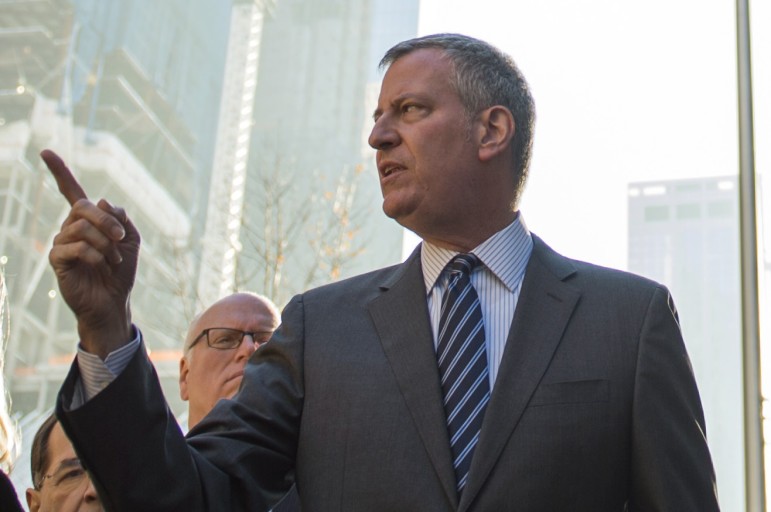
Ed Reed/Mayoral Photography Office
De Blasio has received credit for addressing income inequality as a central goal of OneNYC.
While Bill de Blasio has made nice commitments on climate, his administration has been vague on the details and follow-through on implementation.
Activists hope the COP21 Paris agreement will push the mayor to step up his game – much as the massive September 2015 climate march and the pope’s visit previously spurred action. New York City is a critical global symbol. It is one of the coastal cities most threatened by climate change and sea level rise, as was so devastatingly shown by Hurricane Sandy.
Key issues include whether the mayor will mandate energy retrofits for buildings and how aggressively he will pursue offshore wind. The People’s Climate Movement NY wants the city to adopt a climate action plan to transition to 100 percent renewable energy as soon as possible. San Diego recently released its climate action plan with a goal of 100 percent clean energy by 2035.
Paris was noteworthy for having the world’s political leaders say it is time to get serious about climate change. Now the hard work begins. The climate change reductions proposed by individual nations fall far short of keeping global warming under the old target of 2 degrees centigrade – let alone the new goal of 1.5 degrees.
De Blasio joined with a thousand other mayors to pledge action on climate change. Before Paris, he proposed divesting the city pension funds from coal and to study the carbon footprint of the rest – far short of the total divestment from fossil fuels called for by 350.org but a positive step. The city also announced it wants to purchase 100 percent of its own electricity from new renewable energy.
The Monday after Paris, the de Blasio administration testified to a City Council hearing on climate change and OneNYC, the current mayor’s update and recasting on Mayor Bloomberg’s PlanNYC. De Blasio has received credit for addressing income inequality as a central goal of OneNYC. OneNYC also sets a goal of Zero Waste for garbage – but avoids a position on the proposal plastic bag law.
Unfortunately, the de Blasio plan envisions a large role for natural gas, despite the fact that short-term methane is 87 more potent as a greenhouse gas than carbon dioxide.

No Backspace is City Limits' new blog featuring a recurring cast of opinion writers passionate about New York people, policies and politics.
OneNYC sets goals but avoids the details on how to accomplish them. Councilmember Mark Treyger co-chaired the hearing and pushed for benchmarks and timelines. He also called for real public input, especially from communities most impacted by Sandy.
Buildings account for three-quarters of the city’s carbon footprint. Six years ago Bloomberg began requiring energy audits for large buildings. He assumed that wealthy owners would jump at the chance to save money and make improvements that were cost-effective. They haven’t.
Before the hearing, the City Council’s Progressive Caucus endorsed the labor-backed Climate Works for All plan to mandate energy retrofits and to solarize the city’s schools. Councilmember Brad Lander of Park Slope, a Caucus co-founder, repeatedly asked Nilda Mesa of the Mayor’s Office of Sustainability if she had any belief that the voluntary approach to energy retrofitting was ever going to produce the needed action. “If you can’t give me hope, then we should move now to a mandate.” Despite repeated back and forth, Mesa never expressed hope.
The administration’s testimony regarding offshore wind (OSW) was no more encouraging. The administration had previously expressed support for OSW as part of the city’s purchase of renewable energy. At the hearing its representatives talked more about a go-slow approach in light of financial concerns. Yet government studies say the best way to lower costs would be a commitment to purchase a large amount of OSW electricity at a fixed price over 15 years. This would attract the infrastructure investment needed to slash prices. Whichever community first goes big on OSW will reap the economic and job bonanza as OSW builds out along the east coast.
The area off of Long Island is the OSW gold mine in the U.S. The federal government says its development is its number one priority. In vetoing the proposed Port Ambrose Liquefied Natural Gas facility off of Long Island, Gov. Cuomo noted it would impede the development of OSW.
As the pope pointed out in his encyclical, politicians have failed in their responsibility to deal with climate change. They have offered timid half-measures that will not solve the problem, protecting the wealthy ahead of the well-being of the many.
The era of fossil fuels is over. The main question is whether the transition to 100 percent clean energy will happen soon enough to avoid the most devastating impacts of climate change. De Blasio needs to help answer that in the affirmative.









One thought on “No BackSpace:
Will Bill de Blasio Fulfill his Promise as a Global Climate-Change Leader?”
Pingback: Energy in Depth | Governor Cuomo Bans Fracking, Announces Major Climate Plan Powered by Natural Gas